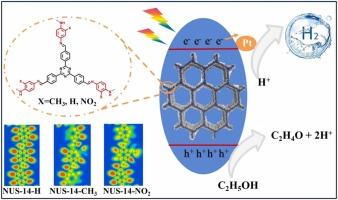取代基对酮胺COFs光催化乙醇重整制氢的影响
IF 6.3
2区 材料科学
Q2 CHEMISTRY, PHYSICAL
引用次数: 0
摘要
乙醇光催化重整为以天然无毒乙醇为原料生产氢能提供了一条有效途径。然而,光催化性能仍然受到光生成载流子快速重组和光收集能力不足的限制。本文合成了一系列具有不同吸电子和给电子基团的酮胺基COFs,即NUS-14-X (X=-H, -CH3, -NO2)。系统研究了引入官能团对具有相同主骨架的二维COFs晶格结构、形貌和电子结构的影响。结果表明,引入吸电子基团(即-NO2)可显著提高制氢效率。最佳样品的光催化效率为5.218 mmol·h−1·g−1,是us -14- h纯样品的2.7倍。一系列的光电化学表征证实了NUS-14-NO2具有更宽的光吸收范围和显著提高的光生电子空穴分离效率。此外,DFT计算表明,吸电子基团可以增强π共轭作用,增强π-电子体系的光吸收和载流子迁移率,从而提高整体的光催化活性。这些结果强调了酮胺基COFs中吸电子取代基和供电子取代基对提高乙醇转化光催化制氢的关键作用。本文章由计算机程序翻译,如有差异,请以英文原文为准。

Effects of substituents on photocatalytic ethanol reforming to hydrogen production over ketoenamine COFs
Photocatalytic reforming of ethanol provides an effective way to produce hydrogen energy using natural and nontoxic ethanol as raw material. However, photocatalytic performance remains limited by the rapid recombination of photogenerated charge carriers and insufficient light-harvesting capability. Herein, we synthesized a series of ketoenamine-based COFs with different electron-withdrawing and electron-donating groups, namely NUS-14-X (X = -H, -CH3, and -NO2). The effects of introducing functional groups on the lattice structure, morphology, and electronic structure of 2D COFs with the same host framework were systematically investigated. Results show that introducing of electron-withdrawing groups (i.e., -NO2) significantly enhances the hydrogen production efficiency. The photocatalytic efficiency of the optimal sample is 5.218 mmol·h−1·g−1, which is 2.7 times that of the pure NUS-14-H. A series of photoelectrochemical characterizations confirmed that NUS-14-NO2 exhibits a broader light absorption range and significantly improved photogenerated electron-hole separation efficiency. Furthermore, DFT calculations revealed that electron-withdrawing groups can promote stronger π-conjugation, enhancing light absorption and charge carrier mobility within the in-plane π-electron system, thereby contributing to the overall photocatalytic activity. These results emphasize the critical role of electron-withdrawing and electron-donating substituents in ketoenamine-based COFs for enhancing photocatalytic hydrogen production from ethanol reforming.
求助全文
通过发布文献求助,成功后即可免费获取论文全文。
去求助
来源期刊

Journal of Alloys and Compounds
工程技术-材料科学:综合
CiteScore
11.10
自引率
14.50%
发文量
5146
审稿时长
67 days
期刊介绍:
The Journal of Alloys and Compounds is intended to serve as an international medium for the publication of work on solid materials comprising compounds as well as alloys. Its great strength lies in the diversity of discipline which it encompasses, drawing together results from materials science, solid-state chemistry and physics.
 求助内容:
求助内容: 应助结果提醒方式:
应助结果提醒方式:


